- Iterate
- Employee Engagement & Retention
- How to Create A Positive Work Environment For Employees With ADHD
How to Create A Positive Work Environment For Employees With ADHD
Table of contents
With the onset of more education and resources, and even social media, it’s easier than ever for organizations to create a positive work environment for those with ADHD.

Utilize their strengths and assist with their weaknesses
Dr. Sasha Hamdani, psychiatrist and ADHD clinical specialist, says that people with ADHD have a lot to offer, such as creativity, good social skills, rapid problem solving and bursts of hyperfocus.
Many people with ADHD excel at relationship-focused roles where they engage with others. However, more detail-oriented work such as paperwork can be extremely challenging. This is because they process information differently. To help with this, you can ask questions about what parts of their job feel difficult and what can be automated.
“Ask how your team member likes to receive, process, and send information,” Arielle Hale, a CEO and certified business coach with ADHD, told The Org. “For example, I prefer to receive written communication. My brain retains the information better, and it's easier for me to come back. I prefer to send voice messages as it helps me get the information out quickly, and I don't get stuck over-explaining or editing. I also need time to work alone and without interruption or something that could take me 30 minutes to get done will take 5 hours.”
Understand that workers with ADHD may work differently
Often, those with ADHD operate at different levels depending on the time of day, with many finding their best work done at night. So it’s in the business’s best interest to give them the freedom to maximize that efficiency rather than expecting them to slog through the workday.
Hamdani recommends offering a more flexible schedule so that those with ADHD can tailor it to the times they’re most efficient, frequent breaks, and space away from distractions.
“Each person has certain conditions that optimize their work performance, so the best thing an employer can do is communicate with them on the front end,” Hamdani said.
Hale also recommends normalizing it. “In our client onboarding form, we ask if our client is neurodivergent, what type of neurodivergence they manage, and how we can best accommodate them.”
Normalize conversations around neurodivergence
“The best way to be an ally is to know what you’re advocating for,” Hamdani said.
New information on neurodivergence and ADHD is easily accessible thanks to the internet. Hamdani recommends resources such as Understood.org and CHADD. She also says social media can be a great source of information if it’s from a credible source.
Neurodivergence isn’t destigmatized overnight, and one way that Nadeau says you can create a more open environment is by hosting educational presentations on neurodivergence and by pointing out highly successful people who do have ADHD and other forms of neurodivergence.
These steps can help create a more educated workforce that is more understanding of neurodivergence and the beneficial accommodations.
Create structures that allow for reminders and focus
Details can be an area of trouble for those with ADHD, and having as much automated as possible can reduce mistakes and set employees up for success.
Tricia Bailey, a client experience manager with ADHD, said, “Stick to and use a CRM system that is automated and chock full of reminders. This way, things won't fall through the proverbial cracks.”
Those with ADHD can have a sense of time-blindness and need reminders for meetings and tasks. Project management programs like Asana and Trello that automate reminders to Slack or email can also be beneficial.
“Hyperfocus is also common, and interrupting someone who is neurodivergent mid-task almost guarantees the task will not get completed,” Bailey said.
Understand and offer accommodations
A good work environment advocates for employees even when they can’t advocate for themselves. Those who are neurodivergent may not know the resources and accommodations available. Making this information accessible and easy to understand can normalize conversations around accommodations. Nadeau recommends the Job Accommodations Network, a non-profit organization that offers resources and ideas on workplace accommodations for both individuals and employers.
“Employers can create a supportive environment by learning about neurodivergence so they can provide accommodations based on a neurodivergent employee’s actual needs,” Caperton Gillett, a senior creative copywriter with ADHD and autism, said. “ And they need to treat those accommodations as normal things and not some kind of burden. If management sees a neurodivergent employee as a necessary burden and a pain in the ass, that’s going to trickle down to the rest of the employees.”
Creating an environment that not only normalizes neurodivergence but celebrates it is not simple, but it is so worth it as it brings in a diversity of thought, creating solutions, ideas, and strategies that wouldn’t usually be apparent.
“Another misconception is that people with ADHD cannot be hard workers,” Hamdani said, “with appropriate management, people with ADHD can exceed expectations.”
Neurodivergent people are not a burden to businesses; they’re an incredible asset. When they are treated as such, and their workspace is adjusted to help them perform optimally, beautiful opportunities and potential are unlocked.
Sign up now: Stay up to date, level up and hire better with our behind the scenes newsletters at the world’s top startups.


The ORG helps
you hire great
candidates
Free to use – try today